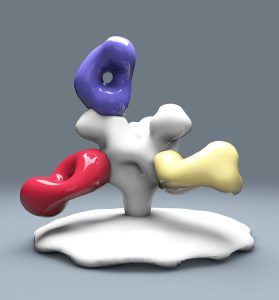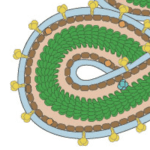

The three monoclonal antibodies that comprise ZMapp (called c13C6, c2G4, and c4G7) were produced by immunizing mice with a recombinant vesicular stomatitis virus in which the glycoprotein was replaced with that from Ebola virus. Antibodies that bound the viral glycoprotein and protected mice from infection were identified, and three were made to resemble human antibodies and produced in tobacco plants. Ecco Zmapp!
Embedded in the membrane of the filamentous Ebola virus particle are many copies of the 

To determine how the antibodies bind the virus particle, they were individually mixed with purified Ebola virus glycoprotein, and the structures were determined by electron microscopy and image reconstruction. The results, shown in the illustration, indicate precisely where each antibody binds to the Ebola virus glycoprotein. The individual antibodies colored red (c2G4), yellow (c4G7), and purple (c13C6) are bound to a single Ebola virus glycoprotein in white, with the viral membrane below (Image credit).
The structures reveal that c13C6 (purple) binds at the tip of the viral glycoprotein, perpendicular to the plane of the viral membrane. The other two antibodies (red, yellow) bind at the base of the viral glycoprotein. Their binding sites overlap but are not identical (the Ebola virus glycoprotein is a trimer, and in the image, the yellow and red antibodies are shown binding to different subunits for clarity). Two other antibodies that block Ebola virus infection also bind at the base of the glycoprotein.
Antibody c13C6, which binds to the tip of the viral glycoprotein, does not neutralize viral infectivity. Nevertheless, it can protect animals from Ebola virus infection. This observation suggests that the c13C6 antibody may work in concert with complement, a collection of serum proteins, to block virus infection. It is not known why c13C6 antibody is non-neutralizing, but one possibility is that it binds to a part of the viral glycoprotein that is removed by an endosomal protease, cathepsin, before receptor binding in late endosomes.
Antibodies c2G4 and c4G7, which bind to the membrane-proximal part of the viral glycoprotein, neutralize viral infectivity. How they do so is not known, but one possibility is that they prevent structural changes of the viral protein that are essential for the fusion with the endosomal membrane, a process that delivers the viral nucleic acid into the cell cytoplasm.
These studies reveal two general areas of the Ebola virus glycoprotein that are important targets for antibodies that protect animals from Ebola virus infection. Those directed at the base of the glycoprotein neutralize infectivity while those that bind the tip do not. This information can now be used to isolate additional antibodies that bind either site. These can be used in animal protection studies to design mixtures that are even more potent than ZMapp.

Mine is a very naive question. How much is this glycoprotein conserved among the different strains of Ebola (Sudan, Zaire, …)? Is there any evidence that the ongoing evolutionary process (see below *Note*) has affected this GP and more specifically the epitopes targeted by this (multi-Ab) drug?
*Note*
In a very recent talk by an Italian Chimps etologist, working in a
protected (but open) Chimp “reserve” in western Africa (the core of the
Ebola crisis), she was puzzled by the apparent lack of deaths among the
primates. As all of you know, during the past, and much less diffuse,
Ebola outbreaks (Congo, …), primate population had been decimated by
the virus. This seems to her (and to me) that virus has indeed changed
becoming more and more “human”. And this is not much of a surprise.
Pingback: How ZMapp antibodies bind to Ebola virus | Host...
Excellent and insightful read.
Pingback: How ZMapp antibodies bind to Ebola virus | Viro...
Pingback: How ZMapp antibodies bind to Ebola virus | Anti...
Zaire Ebola GP protein
is not highly conserved in various serotypes: Bundibugyo (65%), Tai Forest D’Ivoire
(64%), Sudan (54%), Reston (57%). In general, antibodies to Zaire Eboal GP do not cross react with other sereotypes. Therefore, a vaccine against Zaire may not protect against Sudan or Marburg.
That’s to say that this potential “lack of general coverage” should also negatively affect the usage of Zmapp as the drug of choice. It may work in Sierra Leone but not in a future Sudan outbreak
I can’t help but to think the vaccination program on influenza each year can be applied toward Ebola in endemic areas. As Ebola strains change and evolve, vaccine makers will design recombinant viral proteins that’ll stimulate immune system’s antibody production to give recipients best chance to combat current viral strain(s) in a particular area.
Of course, that’ll take active surveillance on Ebola as well as robust support infrastructures for those ongoing efforts in endemic areas. An important part should also include a more effective public education on Ebola. That would involve the public as the first line of surveillance, instead of fear and hysteria that compounds an outbreak. If this works, it would at least limit the future outbreaks to manageable sizes without overwhelm any country’s healthcare system.
Lastly, would bait the suspected species help to reduce Ebola’s natural reservoir? If vaccine works, maybe a baiting suspected species population (much like in rabies control) be considered to further shrink Ebola’s natural reservoir and reduce future outbreaks.
Pingback: Holiday Ebola Update, Sat, 11/29: | Dr. Bob's Blog
Pingback: How ZMapp antibodies bind to Ebola virus | Tool...
Pingback: Evening Ebola Update, Mon, 12/1: | Dr. Bob's Blog
we should induce the influenza virus and on showing the symptoms we should expose the animal to the ebola that technique should be practice in lab animal studies …
All the money that some of us spend trying to stop freedom, should go to more research,think about it,we want to talk to aliens, then we better get our house in order before there will not be any human here on earth.
Thank you Prof. V Racaniello. Do all mucin-domain recognising antibodies non-neutralizing or are there exceptions? Is anything known about why antibodies binding to other conserved regions can be non-neutralizing?
I see this question has not been answered. Interesting thought, but we do observe both neutralizing and non-neutralizing antibodies that span the whole of the virus glycoprotein. There may be some “hot” spots for one area versus another, will have to ponder that question. Keep in mind that antibodies are very diverse, even epitope specific antibodies with various, isotypes, glycosylation patterns, all of these often subtle differences impact the final function(s). Neutralization is just one of the many functional aspects of antibodies and fortunately or unfortunately, was the first function to be understood and “easily” replicated in an in vitro assay. As a result, we have become focused on this function and this aspect of antibodie in protection. However, even neutralizing antibodies can have multiple functions that are far greater than simply “blocking virus”. I like the term protective versus non-protective. A continuum of antibodies are theoretically produced in a response ranging from those that can enhance infection, to those with neutral impact (non-protective), to those critical for stopping the infection (protective). I have isolated neutralizing antibodies (in a cell culture assay) that were not protective and visa versa…. So it is more complex than we thought! Why I love science so much